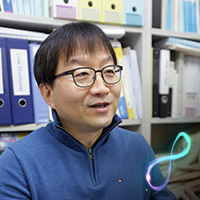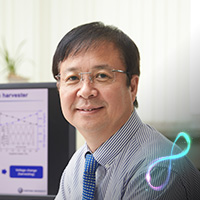Hanyang’s Unique Research Capabilities Built on a History of Practical Academics

The era of technological revolution is changing at a frightening pace! Where is university research heading in the days of the 4th Industrial Revolution? What is the secret to Hanyang’s outstanding research that has been leading the era of the 4th Industrial Revolution? The answer can be found in Hanyang’s 80-year history.
For the past 80 years, beginning in 1939 when Hanyang University launched its education program based on the founder’s idea of “making the nation rich and strong through technology education,” that idea has continued through the university’s educational philosophy of offering “practical academics.” Hanyang University has always supported research and education that help society and the nation, and this has gained even more significance in the era of the 4th Industrial Revolution. The following eight representative researchers and their astonishing research results show how Hanyang University is leading the era of the 4th Industrial Revolution.
 Professor Kim Ki-hyun, Civil and Environmental Engineering
Professor Kim Ki-hyun, Civil and Environmental Engineering
Developed technology that eliminates air pollution-causing matter
Professor Kim Ki-hyun has developed a new material related to improving the environmental analysis system that controls and manages Volatile Organic Compounds (VOC) and bad smells. Benzene and formaldehyde are kinds of VOCs, which are class one carcinogens that can be produced in daily life when people cook, drive, or smoke. Current air purification technology has limitations in detecting and eliminating such carcinogens, since they only specialize in dust elimination. Combining metal and carbon organic matter, Professor Kim developed Metal Organic Frameworks (MOF) and succeeded in adsorbing and eliminating such pollution particles. In addition, he simultaneously developed technology that effectively concentrates samples, such as toxic substances, and suggested a new air quality diagnosis method that analyses 22 kinds of odor causing materials which have been designated by the Ministry of Environment.
 Professor Kim Sang-wook, Computer Science
Professor Kim Sang-wook, Computer Science
Developed big data graph analyzing technology which is 40 times faster than the current method
Professor Kim developed a single-machine-based graph engine called RealGraph, which has big data analysis capabilities 40 times faster than that of current technology. While planning RealGraph, he used the phenomenon that “real world graph data shows power-law degree distribution, not normal distribution.” (An example of the power-law degree is how on Instagram most users communicate with a small number of other users, while very few users communicate with a large number of users.)
Existing graph engines did not consider power-law degree distribution which caused uneven workload distribution and inefficient memory access, but Professor Kim applied new strategies to solve those problems. As a result, RealGraph performed up to 44 times faster than existing engines when processing large-scale graph big data. His engine is expected to be utilized in various fields such as social media analysis and protein structure analysis, due to its fast analyzing capacity.
 Professor Kim Seon-jeong, Electrical and Biomedical Engineering
Professor Kim Seon-jeong, Electrical and Biomedical Engineering
Artificial Muscle, 40 times stronger than human muscle
Professor Kim Seon-Jeong, together with an international research team including researchers from the University of Texas, developed a new “sheath-run” artificial muscle that is 40 times stronger than human muscle. This newly developed sheath-run artificial muscle has 9 times higher performance than the original artificial muscle, and it was able to solve the economic problem which has been seen as a limitation of existing artificial muscles. Since it no longer uses carbon nanotubes which have a high manufacturing price, and instead uses commercial threads such as nylon and silk, the newly developed technology has a lower material price and thus a much higher commercial value.

Professor Sun Yang-kook, Energy Engineering
Developed a cost-effective, high capacity electronic battery
The main field of research for Professor Sun Yang-kook is cathode materials for lithium-ion batteries and next-generation battery materials. Cathode materials for lithium-ion batteries are a crucial key to solving some critical issues related to electric cars - short driving distance and high cost. In the manufacturing of electric cars, 60% of the total cost is for materials, 44% of which is spent on cathode materials. Therefore, the price of electric cars could be made more affordable if one could lower the price of cathode materials. Using more nickel would help to lower the price and increase the battery capacity, but then stability and battery life would underperform due to increased heat. That is, battery capacity and battery stability and life are in inverse proportions. Professor Sun developed a Full Concentration Gradient Structure cathode material (with increased nickel content in the center and increased manganese content at the surface) to solve the issue. Cheap and stable cathode materials with large capacities can now be manufactured, and these are being used in Kia Motors’ electric vehicle, the Niro EV.
 Professor Sunwoo Myung-ho, Automotive Engineering
Professor Sunwoo Myung-ho, Automotive Engineering
Developed an autonomous vehicle
Professor Sunwoo Myung-ho is a world-class leader in the field of autonomous vehicles. Last March, professor Sunwoo succeeded in operating a 5G based urban, self-driving automobile for the first time in the world with LG U+. It was the first time that a 5G self-driving car succeeded in driving autonomously through congested urban roads full of vehicles. The key to the autonomous vehicle that his team developed are the high-end sensors and deep-learning-based AI. In fact, sensors such as Lidar, Radar, and cameras recognize the nearby environment, and the AI technology drives and responds to lane changes in the front, rear, and sides of other vehicles. Because corresponding AI technology is based on deep learning, it continuously accumulates and analyzes data such as driving on roads, situations, and variables and continues to evolve on its own.
 Professor Sung Tae-hyun, Electrical and Biomedical Engineering
Professor Sung Tae-hyun, Electrical and Biomedical Engineering
Enhancement of energy harvesting technology to change waste energy into electricity
Energy Harvesting technology, which is the primary research of professor Sung Tae-hyun , is a method using an independent source of current for sensors by converting the light energy of fluorescent light and vibration energy that are being discarded at industrial sites into electric energy. There are various Internet of Things (IoT) sensors on the industrial site. Most are supplied with electricity by wire, which makes the installation site limited. If an energy harvester, used as an independent source of power for sensors, is created, products that utilize IoT sensors can be built in various places. The energy harvesting technology of Professor Sung Tae-hyun’s research team is the world's best. In particular, the Piezoelectric Energy Harvesting technology, effective in converting vibration energy into electrical energy, is most prominent. Additionally, professor Sung stated, “Hanyang university possesses the record of 9.38 mW/cm2, which is 16 times the previous world’s highest value of 0.58 mW/cm2 (previously held by Shanghai Jiao Tong University), and we are reaching for 12 mW/cm2 through this research.”
 Professor Lee Young-moo, Energy Engineering
Professor Lee Young-moo, Energy Engineering
Developed technology that drops the price of hydrogen fuel cell to 1/10
Professor Lee Young-moo is an expert of polymer engineering, including a separator, carbon dioxide separation, fuel cells, and polymer materials. He is also famous for serving as the 14th president of Hanyang University while also continuing his research and even publishing in the Scientific Reports Journal ‘Nature’ during his tenure as president of Hanyang. He developed a hydrogen fuel cell separator, which imitates the moisture retention function of cacti. This technology is expected to lower not only environmental pollution but also the price of electric cars that use hydrogen fuel cells.
Hydrogen fuel cells obtain energy through chemical reactions occurring in multiple layers of electrolyte membranes. However, existing electrolyte membranes have a limitation in performance at high temperatures and an inability to maintain moisture for chemical reactions. Professor Lee solved this problem by developing a new membrane modeled after a cactus. With this technology, the hydrogen fuel cell can be made at one-tenth of the existing price, ultimately reducing the price of hydrogen cars by up to 30%.
 Professor Jang Joon-hyuk, Electronic Engineering
Professor Jang Joon-hyuk, Electronic Engineering
Developed a voice recognition technology based on artificial intelligence
Professor Jang Joon-hyuk developed ‘Pluto,’ the first embedded AI speaker in Korea that can recognize voices without connecting to the internet. The existing AI speakers produced by domestic IT companies needed to be connected to a cloud server for voice recognition causing a network delay and security issues in the process. Professor Jang solved this problem by applying an embedded method that incorporates a large voice recognition system with a capacity of 200,000 words into the hardware system. To facilitate voice recognition in a long-distance environment, he developed a ‘beamforming’ technology that eliminates noise for smooth, long-distance voice recognition and a ‘speaker recognition technology’ that only recognizes registered user voices and filters any voices coming from the TV. He also conducted university-industry cooperation with global IT companies with such original technologies. Professor Jang is continuously developing voice recognition technology that can control every device with only one’s voice similar to his other completed technologies like Bixby of Samsung, AI car doctor and voice recognition engine of Hyundai Motors, Q Voice of LG, and ‘Chloe,’ an Incheon International Airport guide robot.
* The list of researchers follows the (Korean) alphabetical order.
글로벌뉴스팀
global@hanyang.ac.kr

